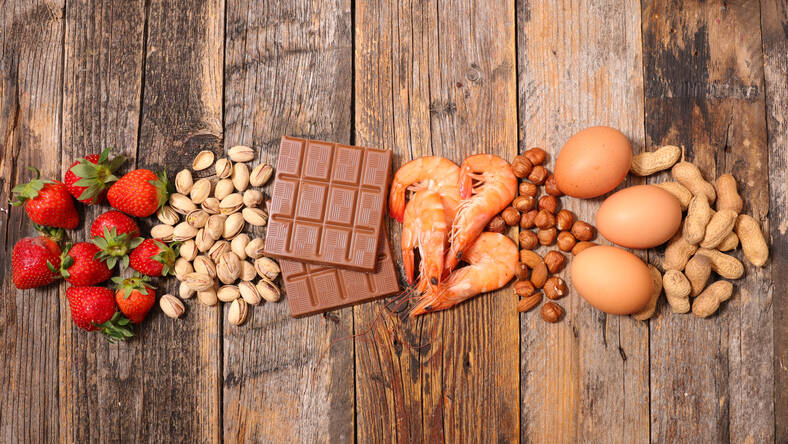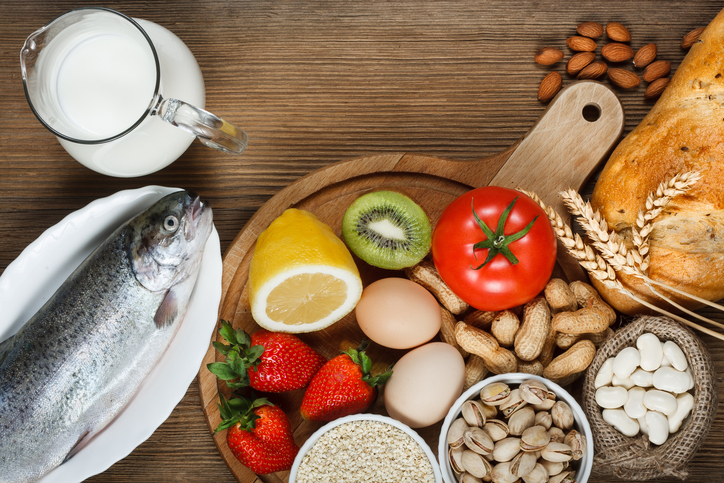- Maintz, L.; Novak, N. (2007). "Histamine and histamine intolerance". American Journal of Clinical Nutrition. 85 (5): 1185–96.
- Moon TC, Befus AD, Kulka M (2014). "Mast cell mediators: their differential release and the secretory pathways involved". Front Immunol. 5: 569.
- "Histamine Intolerance". Healthline.
- "Tissue Expression of HNMT - Summary - Protein Atlas". Tissue Expression of HNMT - Summary - Protein Atlas.
- Maintz, Laura; Bieber, Thomas; Novak, Natalija (25 December 2006). "Die verschiedenen Gesichter der Histaminintoleranz: Konsequenzen für die Praxis". Deutsches Ärzteblatt. 103 (51–52): A-3477 / B-3027 / C-2903.
- "Tissue Expression of AOX1 - Summary - The Human Protein Atlas".
- "Histamine Food List" (PDF). Healing Nore: Health Coaching.
- Wilhelm, T. (15 June 2007). "Tabakrauch ist bedeutende Histaminquelle". Deutsches Ärzteblatt. Köln 104.2007: A 1768.
- lowhistamineeats (2021-06-02). "Do I Have a Chocolate Intolerance (or Chocolate Allergy)?". Low Histamine Eats.
- Schaefers, Nadja (2009). Histaminarm kochen - vegetarisch. pala-Verlag.
- Histamin Intoleranz
- "Histamine intolerance: Causes, symptoms, and test". Medical News Today. 16 April 2021.
- Vogelreuter, Axel (2015). Nahrungsmittelunverträglichkeiten. Stuttgart: S. Hirzelverlag. ISBN 978-3-7776-2349-8.
- "Histamine intolerance: lack of reproducibility of single symptoms by oral provocation with histamine: A randomised, double-blind, placebo-controlled cross-over study". Wiener Klinische Wochenschrift. 2011: 1–2. Retrieved 3 June 2019.
- Greiling, Helmut; Gressner, A.M. (1987). Lehrbuch der klinischen Chemie und Pathobiochemie. Schattauer Verlagsgesellschaft. ISBN 3-7945-0949-8.
What is histamine intolerance, what are the causes, symptoms and treatment?

Histamine intolerance is hypersensitivity to histamine. It's not an allergy. Histamine is produced naturally in our body, but we also take it through food consumption. Some contain more of it, and it causes a variety of difficulties for people suffering from it.
Most common symptoms
- Malaise
- Feeling of heavy legs
- Tremors
- Stomach pain after a meal
- Abdominal Pain
- Headache
- Joint Pain
- Period pain
- Muscle Pain
- Hoarseness
- Spirituality
- Cramps in the abdomen
- Nausea
- Head spinning
- Depression - depressed mood
- Diarrhoea
- Rash
- Bloating - flatulence
- Indigestion
- Low blood pressure
- Swelling of the limbs
- The Island
- Swollen fingers
- Full nose
- Menstrual cycle disorders
- Memory disorders
- Mood disorders
- Tremor
- Buds
- Muscle weakness
- Itchy skin
- Fatigue
- Anxiety
- Damp cough
- Vomiting after eating and nausea
- Vomiting
- Coughing up mucus
- Reddened skin
- Accelerated heart rate
Characteristics
It is not an allergy.
So what histamine intolerance actually is?
The definition says that, in particular, it is a situation where there is a disparity between the supply and the mechanism of histamine degradation. An imbalance can arise from several factors.
How does the imbalance in the above equation result in histamine supply and degradation:
- increased histamine content in the diet
- increased supply of histamine-releasing substances, so-called histamine liberators
- supply of substances that block the enzyme which breaks down histamine
- N-methyltransferase, which breaks down endogenous histamine
- diamine oxidase degrades exogenous histamine (DAO)
- by flushing the body's own histamine to an increased extent
- decreased function of the enzyme that affects the breakdown of histamine
And what is histamine?
Histamine is a biologically active amine. It is found in both plant and animal cells, mainly through degradation as a product of cell metabolism. It is formed during the decomposition of the amino acid histidine or the transamination of aldehydes and ketones.
It was discovered by the British physician, biochemist, physiologist Sir Henry Dale in 1910.
Examples of other biogenic amines are serotonin, adrenaline, noradrenaline, dopamine, or tyramine. These substances are also known as mediators and are used to transmit signals in cells, between cells, and also between organs.
Like other mediators, histamine plays a number of important roles in the body and is essential for life. The body makes it itself, hence it is called endogenous histamine. Exogenous histamine is that which enters the body from outside through food intake.
The level of histamine in food is not constant. It increases during microbial and biochemical processes. This will not prevent food exposure to low temperatures, such as in the refrigerator. Therefore, its values are lower in fresh food and food storage contributes to its increased values.
As described, it is found in both plant and animal cells. It is typically more abundant in fish, cheese, salami, fermented, fermented, or canned foods. It is present in the body mainly in granulocytes and mast cells, where it is bound and released by various stimulations.
Its role in the body is irreplaceable, it is essential for life. People associate it mainly with an allergic reaction when it is released together with other substances after stimulation of IgE antibodies. The action of allergen and IgE antibodies thus causes an allergic reaction.
However, histamine intolerance is not an allergy
There is a fundamental difference between an allergic reaction and intolerance to a substance.
An allergic reaction is an exaggerated response of an organism to a substance that does not normally elicit an immune response. Allergy is mediated by IgE antibodies that the body has developed for the allergen.
These are, for example, mites, dust, pollen, mold, food ingredients, or animal fur. Typically, this reaction is detected by skin tests.
Food component intolerance, as well as histamine intolerance, does not involve an IgE antibody response. Although the reaction is characterized by hypersensitivity, it lacks an allergic basis.
Allergy is characterized by a set of difficulties, such as:
- skin changes
- swelling of the mucous membranes
- swelling of the skin
- sowing of rashes, hives
- itching
- rhinitis and increased mucus secretion or cough
- possibly difficulty breathing
- only one symptom may occur or they may be combined with each other
A feared form of allergy is an anaphylactic reaction.
Interesting information about the anaphylactic reaction in a separate article at the Medical Center.
Where is histamine needed and what is its function?
Histamine is not only present in an allergic reaction. It has various roles throughout the body. It serves as a mediator, also mediates information in cells, between cells and organs.
Its effect on smooth muscles is well known. During an allergic reaction, it acts on the smooth muscle in the wall of the blood vessels, which expands its effect. This causes blood pressure drop or reddening of the skin. Widening of the vessel wall also results in easier fluid leakage from the vessels.
Leaking fluid from the blood vessels causes swelling but also the well-known hives on the skin. Hives are also known under the professional name urticaria. The skin also looks like hives when swallowed, hence the name hives. Dilation of blood vessels in the head causes migraine headaches, abdominal cramps in the digestive system. Histamine irritates nerve endings.
In the table is shown the cross-body activity of histamine
| Organ system | Effects |
| Central nervous system |
|
| Cardiovascular system |
|
| Digestive system |
|
| Blood and bone marrow |
|
| Skin and mucous membranes |
|
| Respiratory system |
|
| Uterus and female reproductive system |
|
Causes
There is a mismatch between the supply and degradation of histamine in the body. Its increased amount in the body is often manifested by various difficulties. Histamine enters the body to a greater extent through food.
The source of histamine is the food itself (plants, animals), but also microorganisms.
These are bacteria that act on food during storage. Examples are products with high protein content, such as fish, meat, cheese. Subsequently, there are foods that indirectly increase histamine levels, such as egg whites, pork, strawberries, citrus, or tomatoes.
It is said to be rare in children if it usually affects boys.
The level of histamine is also increased by pathological intestinal microflora, bleeding in the digestive tract, and also substances that release histamine, so-called liberators. Decreased activity of enzymes, ie their blockade is caused by various substances, some drugs, diseases of the digestive tract, especially chronic inflammation of the intestine. Although rare, a genetic defect in enzyme production can also be the cause, and a mismatch in the mechanism sometimes occurs in a healthy person.
Histamine intolerance arises due to a disproportion in the level of:
- excessive histamine intake in food
- increased supply of histamine-releasing substances, so-called histamine liberators
- supply of substances that block the enzyme that breaks down histamine
- N-methyltransferase, which breaks down endogenous histamine
- diamine oxidase degrades exogenous histamine
- by flushing the body's own histamine to an increased extent
- reduced function of the enzyme acting on the breakdown of histamine
The enzyme that is responsible for the breakdown of exogenous histamine, or diamine oxidase (DAO), is present in different amounts in each person and its functionality is different. The best effectiveness of this enzyme is in childhood. It is said to decrease with age.
Histamine intolerance affects approximately 3% of the population.
80% of them are middle-aged.
It affects women more often.
The enzyme DAO is found and acts in the digestive tract, it is also found in the kidneys or placenta. This form affects the exogenous type that we eat. The enzyme N-methyltransferase is responsible for the endogenous type and elimination of histamine, which the body produces itself. It works inside the cell, so it doesn't even get into the blood.
Histamine values and histamine intolerance
The highest secretion of DAO occurs in the small intestine and the descending part of the large intestine. This part of the digestive tract is a major barrier to histamine's access to the blood. The normal level is 0.3 - 1.0 ng / ml. Difficulties occur if this value is exceeded.
Symptoms
Histamine intolerance is not an allergy, although some symptoms are misleading.
The table shows the distribution of symptoms according to the body system
| Organ system | Symptoms | Description |
| Digestive tract |
|
difficulties occur mainly after eating a risky diet after a few minutes to an hour The cause of pain is the expansion of smooth muscle in the walls of blood vessels and intestines Contributions are caused by conditions such as: irritable bowel syndrome Crohn's disease ulcerative colitis |
| Skin |
|
urticaria is also a consequence of the dilation of small skin vessels, and thus the passage of fluid outside the blood vessels as well as greater swelling, there is also a connection with diseases such as: atopic eczema dermatitis or hypersensitivity to the sun |
| Joints and muscles |
| as a consequence of inflammation, ie arthritis, and thus an association with rheumatoid arthritis |
| CNS |
| histamine affects nervous excitability but also other neurotransmitters headache has a migraine character also for dilation of blood vessels in the brain worsens its head movement |
| Psyche |
| connection with action on the CNS |
| Cardiovascular system |
| also as a consequence of vasodilation, it affects hematopoiesis such as mast cell secretion or white blood cells |
| Respiratory system |
| |
| Female genital system |
| difficulties tend to be chronic |
Diagnostics
The DAO enzyme level can be determined during diagnosis. However, this method does not have 100% success and may show false results. The value of histamine alone is difficult to determine because it has a very short disintegration time.
Differential diagnosis also includes blood tests for basic parameters, blood count, biochemistry, sugar, liver tests. IgE level, inflammatory parameters, CRP, eosinophil count are determined. In addition, other examinations are supplemented according to the difficulties encountered. Such as neurological, dermal, cardiological. Endoscopy, X-ray, USG, or CT for abdominal pain.
Caution: it is important to think about milk or gluten intolerance .
The main method for making a diagnosis is, in particular, the thorough collection of information about the clinical picture, ie the difficulties affecting the person concerned. An elimination diet and a subsequent load test with foods that have a higher concentration of histamine are helpful.
The doctor finds out various information and the main questions include:
- is there a link between food consumption and difficulties?
- what is the time period from consumption to symptoms
- identification of problematic foods even with their approximate histamine value
- there are other diseases or allergies
- what is the clinical finding and examination from head to toe
- for example, the condition of the skin, its color, rash
- breathing, cough, wheezing
- heart rate, acceleration, irregularity, blood pressure
- examination of the abdomen by touch, tapping
Course
Difficulties such as diarrhea, abdominal cramps, bloating are the first wave of digestive problems along with skin manifestations.

The skin shows redness, rashes, and the familiar urticaria, ie hives. The skin itches, even irritate nerve endings. Dilation of blood vessels causes fluid to penetrate from the blood vessels, causing swelling. Dilation of the bloodstream results in low blood pressure. This can cause a collapse.
Symptoms appear in combination, but it is not necessary that they all be named.
Other symptoms, such as those listed in the table, may or may not occur. The overall symptomatology can be mild but also severe. Chronic problems also occur, for example, in the long term in terms of acting on the CNS. There is fatigue or rapid fatigue, memory disorders, concentration, nervousness. Anxiety, depression, even schizophrenia may be associated.
The headache has a migraine character, it is impaired by movement. Over time, muscle weakness and other complications occur, for example in women with difficulties with menstruation, and therefore also with fertility, pregnancy is at risk. The risk of miscarriage is serious.
Suitable and unsuitable foods for histamine intolerance
From the above information, it appears that certain content of histamine is found in every plant or animal product. Of course, there is a difference in the total value of the substance contained.
Diet includes limiting the consumption of foods that have higher levels of histamine, but also diets that affect the production of histamine.
It is important to realize what one can eat, and what should not be eaten.
The table shows the approximate values of histamine in some foods and beverages
| Product | Approximate histamine content in mg per 100 g |
| Sardines | up to 1500 |
| Tuna | up to 1300 |
| Mackerel | to 30 |
| Salami | to 28 |
| Ham, sausages | to 16 |
| Emmental | to 60 |
| Parmesan | to 20 |
| Gouda | to 18 |
| Cheddar | to 5 |
| Yogurt | up to 0.2 |
| Sauerkraut | to 20 |
| Spinach | to 6 |
| Tomatoes | to 2 |
| Wine vinegar (balsamic) | up to 400 |
| Apple vinegar | to 2 |
| Alcohol | Value in / g / 100 g |
| Red wine | to 380 |
| Wine | to 40 |
| Beer | to 30 |
The value of histamine with food is not constant. Fresh products contain the smallest amount.
Subsequently, it gradually increases.
This is due to the action of microorganisms and breakdown mechanisms in the cells themselves. Even storing food in a refrigerator at 4 ° C will not prevent it from deteriorating. Freezing and preparation immediately after thawing will help.

The table lists permitted and prohibited foods and regimens for histamine intolerance
| Appropriate food | Prohibited foods |
| plain milk | fish |
| cream | Emmental or Gouda cheeses |
| yogurt without flora | sausages, hot dogs |
| fresh ricotta mozzarella cottage cheese | alcohol red wine beer - yeast |
| dark flour | sauerkraut |
| dark pastry | tomatoes |
| plain bread and rolls | citrus |
| homemade cakes and desserts without the content of prohibited ingredients | spinach |
| pure cereal | eggplant |
| oat flakes | strawberries |
| grain wheat rice | pineapple |
| rice bread | bananas (histamine is mainly in the peel) |
| persimmon | chocolate |
| pea sprouts | stored meat, chicken meat |
| onion garlic | other fermented foods |
|
potatoes sweet potatoes broccoli melon cucumber | fresh pastry sourdough white flour yeast commercially sold cakes, desserts, baking mixes |
| Brazil nuts pistachio olive oil, coconut oil | sour, ie acidophilic milk probiotic yogurts buttermilk or sheep milk cheese |
| mulberry | nuts |
| holy thyme basil | Licorice |
| tarragon | canned food |
| nettle | margarine |
| measure | spices such as cloves, anise, or cinnamon |
| ginger | some fruit teas, artificially flavored |
| turmeric | additives such as colorants, stabilizers, flavorings |
|
apple pear peach blueberries currant apricot pomegranate capers | some drugs from the group: antibiotics antiarrhythmics antihypertensives diuretics antidepressants anesthetics antiseptics contrast agents analgesics |
| real tea from tea tree even though it contains histamine, but its negative effect on long-term drinking has not been proven can be white, green, oolong (partially fermented), or fermented |
allergic reaction (releases histamine) infection injury, shock |
| Suitable mode | Inappropriate mode |
| consumption of food with a histamine content of less than 5 mg / 100 g and restriction of histamine in other dietary components | combination of several foods containing histamine |
| consumption of fresh fish | food storage |
| The maximum storage time of 24 hours is conditional on cold storage after consumption | food heating |
| probiotics | smoked, salted, and preserved foods |
| vitamin C | long cooking and roasting of meat |
| vitamin B 6 maximum 50 mg per day | |
| raw fruits and vegetables | |
| storage of meat only by freezing |
How it is treated: Histamine intolerance
Treatment of histamine intolerance: medication and diet
Show moreWhat we know about histamine intolerance
Histamine intolerance is treated by
Histamine intolerance is examined by
Other names
Interesting resources










